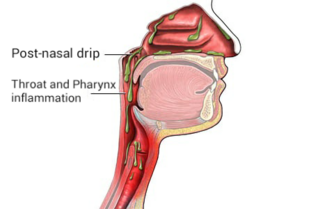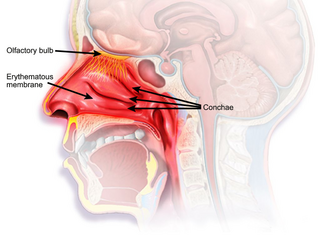
The common cold or the cold is a viral infectious disease of the upper respiratory tract that primarily affects the respiratory mucosa of the nose, throat, sinuses, and larynx. Signs and symptoms may appear in as little as two days after exposure to the virus. These may include coughing, sore throat, runny nose, sneezing, headache, and fever. People usually recover in seven to ten days, but some symptoms may last up to three weeks. Occasionally, those with other health problems may develop pneumonia.

Xylometazoline, also spelled xylomethazoline, is a drug used to reduce symptoms of nasal congestion, allergic rhinitis, and sinusitis. Use is not recommended for more than seven days. Use is also not recommended in those less than three months of age and some say not less than 6 years of age. It is used directly in the nose as a spray or drops.

Cold medicines are a group of medications taken individually or in combination as a treatment for the symptoms of the common cold and similar conditions of the upper respiratory tract. The term encompasses a broad array of drugs, including analgesics, antihistamines and decongestants, among many others. It also includes drugs which are marketed as cough suppressants or antitussives, but their effectiveness in reducing cough symptoms is unclear or minimal.
Dexbrompheniramine/pseudoephedrine is a combination medication that contains the antihistamine dexbrompheniramine maleate and the decongestant pseudoephedrine sulfate. It was used to treat symptoms associated with allergies and colds such as itchy and watery eyes, runny nose, nasal and sinus congestion, and sneezing. Because it contains pseudoephedrine, its purchase in the United States was severely restricted by the Combat Methamphetamine Epidemic Act of 2005 over fears that any product containing pseudoephedrine can be used to make methamphetamine.
A decongestant, or nasal decongestant, is a type of pharmaceutical drug that is used to relieve nasal congestion in the upper respiratory tract. The active ingredient in most decongestants is either pseudoephedrine or phenylephrine. Intranasal corticosteroids can also be used as decongestants and antihistamines can be used to alleviate runny nose, nasal itch, and sneezing.
Topical decongestants are decongestants applied directly to the nasal cavity. Their effectiveness by themselves in the common cold appears to have a small benefit in adults.

Propylhexedrine, sold under the brand name Benzedrex among others, is an alkylamine primarily utilized as a topical nasal decongestant. Its main indications are relief of congestion due to colds, allergies, and allergic rhinitis. Propylhexedrine was first used medically in 1949, with the release of Benzedrex by Smith, Kline & French, and it has been used, mainly within the United States, since then.

Phenylephrine, sold under the brand names Neosynephrine and Sudafed PE among others, is a medication used as a decongestant for uncomplicated nasal congestion, to dilate the pupil, to increase blood pressure, and to relieve hemorrhoids. It can be taken by mouth, as a nasal spray, given by injection into a vein or muscle, applied to the skin, or as a rectal suppository.

Oxymetazoline, sold under the brand name Afrin among others, is a topical decongestant and vasoconstrictor medication. It is available over-the-counter as a nasal spray to treat nasal congestion and nosebleeds, as eye drops to treat eye redness due to minor irritation, and as a prescription topical cream to treat persistent facial redness due to rosacea in adults. Its effects begin within minutes and last for up to six hours. Intranasal use for longer than three to five days may cause congestion to recur or worsen, resulting in physical dependence.

Nasal congestion is the partial or complete blockage of nasal passages, leading to impaired nasal breathing, usually due to membranes lining the nose becoming swollen from inflammation of blood vessels.

Post-nasal drip (PND), also known as upper airway cough syndrome (UACS), occurs when excessive mucus is produced by the nasal mucosa. The excess mucus accumulates in the back of the nose, and eventually in the throat once it drips down the back of the throat. It can be caused by rhinitis, sinusitis, gastroesophageal reflux disease (GERD), or by a disorder of swallowing. Other causes can be allergy, cold, flu, and side effects from medications.

Naphazoline is a medicine used as a decongestant, and a vasoconstrictor added to eye drops to relieve red eye. It has a rapid action in reducing swelling when applied to mucous membranes. It is a sympathomimetic agent with marked alpha adrenergic activity that acts on alpha-receptors in the arterioles of the conjunctiva to produce constriction, resulting in decreased congestion.

Rhinitis medicamentosa is a condition of rebound nasal congestion suspected to be brought on by extended use of topical decongestants and certain oral medications that constrict blood vessels in the lining of the nose, although evidence has been contradictory.
Actifed is a registered trademark for a combination antihistamine and nasal decongestant medication used for cold and allergy symptoms. Actifed was developed in 1958 by Burroughs Wellcome & Company, later Haleon.

Levmetamfetamine, also known as l-desoxyephedrine or levomethamphetamine, and commonly sold under the brand name Vicks VapoInhaler among others, is an optical isomer of methamphetamine primarily used as a topical nasal decongestant. It is used to treat nasal congestion from allergies and the common cold. It was first used medically as decongestant beginning in 1958 and has been used for such purposes, primarily in the United States, since then.

Cyclopentamine is a sympathomimetic alkylamine, classified as a vasoconstrictor. Cyclopentamine was indicated in the past as an over-the-counter (OTC) medication for use as a nasal decongestant, notably in Europe and Australia, but has now been largely discontinued.

Ear clearing, clearing the ears or equalization is any of various maneuvers to equalize the pressure in the middle ear with the outside pressure, by letting air enter along the Eustachian tubes, as this does not always happen automatically when the pressure in the middle ear is lower than the outside pressure. This need can arise in scuba diving, freediving/spearfishing, skydiving, fast descent in an aircraft, fast descent in a mine cage, and being put into pressure in a caisson or similar internally pressurised enclosure, or sometimes even simply travelling at fast speeds in an automobile.

Tuaminoheptane is a sympathomimetic agent and vasoconstrictor which was formerly used as a nasal decongestant. It is still used in France as a nasal decongestant but its use is not recommended by the health authorities due to the lack of evidence of its effectiveness. It has also been used as a stimulant.

Metizoline is a nasal decongestant against allergic and vasomotor rhinitis.
Rhinomanometry is a form of manometry used in evaluation of the nasal cavity. Rhinomanometry is a standard diagnostic tool aiming to objectively evaluate the respiratory function of the nose. It measures pressure and flow during normal inspiration and expiration through the nose. Increased pressure during respiration is a result of increased resistance to airflow through nasal passages, while increased flow, which means the speed of airstream, is related to better patency. Nasal obstruction leads to increased values of nasal resistance. Rhinomanometry may be used to measure only one nostril at a time or both nostrils simultaneously.















